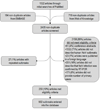The epidemiology of published norovirus outbreaks: a review of risk factors associated with attack rate and genogroup
- PMID: 22444943
- PMCID: PMC3350621
- DOI: 10.1017/S0950268812000234
The epidemiology of published norovirus outbreaks: a review of risk factors associated with attack rate and genogroup
Abstract
The purpose of this study was to examine global epidemiological trends in human norovirus (NoV) outbreaks by transmission route and setting, and describe relationships between these characteristics, viral attack rates, and the occurrence of genogroup I (GI) or genogroup II (GII) strains in outbreaks. We analysed data from 902 reverse transcriptase-polymerase chain reaction-confirmed, human NoV outbreaks abstracted from a systematic review of articles published from 1993 to 2011 and indexed under the terms 'norovirus' and 'outbreak'. Multivariate regression analyses demonstrated that foodservice and winter outbreaks were significantly associated with higher attack rates. Foodborne and waterborne outbreaks were associated with multiple strains (GI+GII). Waterborne outbreaks were significantly associated with GI strains, while healthcare-related and winter outbreaks were associated with GII strains. These results identify important trends for epidemic NoV detection, prevention, and control.
Figures

References
-
- Teunis PF, et al. Norwalk virus: how infectious is it? Journal of Medical Virology. 2008;80:1468–1476. - PubMed
-
- Leon J, Moe CL. Role of viruses in foodborne disease. In: Potter M, editor. Food consumption and disease risk: consumer-pathogen interactions. Baltimore: Woodhead publishing in food science, technology and nutrition; 2006.
Publication types
MeSH terms
Grants and funding
LinkOut - more resources
Full Text Sources
Other Literature Sources
Medical

